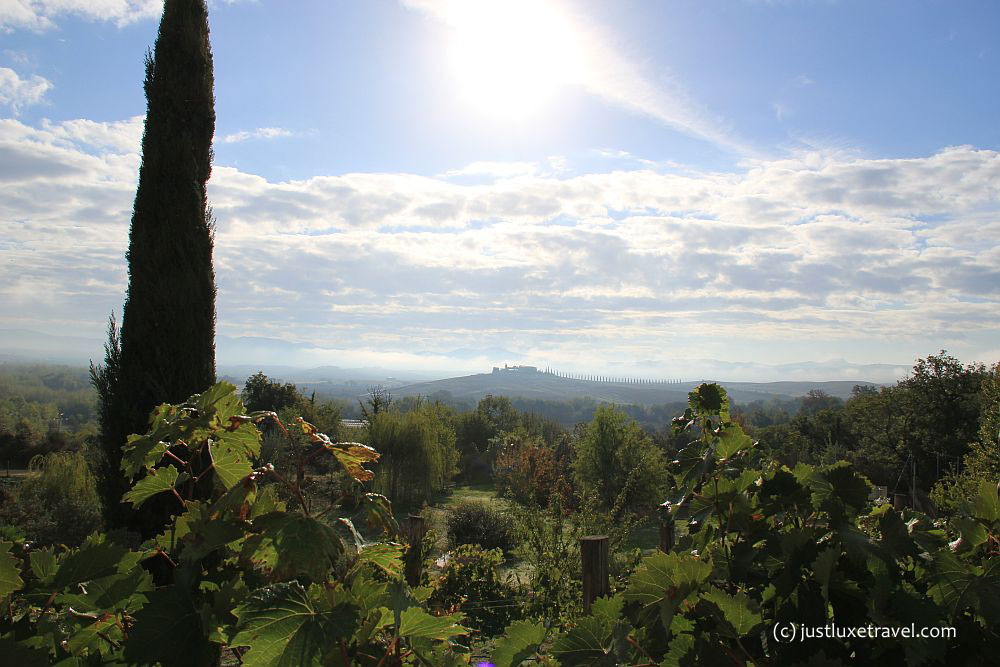From Pisa, it is not far to the world-famous wine region Chianti so I pick up my small rental car and start my journey to the South.
The car snorts up the tiny road to the Villa Le Barone and swirls up a huge cloud of dust. I left the paved roads of Pinzano in Chianti behind and now we roll through the vineyards to the ancient mansion of the sculptor family Della Robbia.
The landlord Count Corso de Larderel is cheerfully wafing at me at the archway.
His cousin Duchess Visconti Franco renovated the former Fattoria (an Italian farm) and converted it into a small hotel with 30 rooms. “In Chianti it’s always very cozy and familiar” the Earl smiles relaxed and opens the creaking door to my ancient  bedchamber of Villa le Barone.
bedchamber of Villa le Barone.
On this sunny afternoon the cook plucks fresh parsley for the classic Tuscan ribollita vegetable stew in the vast park. The region in Northern Italy is known for its simple dishes with great taste.
The formerly poor, rural population cooked with cheap ingredients and warmed up the dishes from the day before. The Ribollita was originally considered as a poor man’s food and means “boiled again”. But flavor and taste are particularly intense when the stew is warming up again and again.
Today, the Tuscan specialty can also be found in gourmet restaurants on the menu.
And so this evening I was invited to a dinner with the owner and his wife in the cosy hotel restaurant. I am fascinated by the intense flavor of the actually so simple course called Ribollita. The ingredients are dependent on the season, but white beans, tomatoes, cabbage and stale bread are always part of it. Originally, the vegetable soup was made from the soup the people made the day before. First bread slices were placed in a bowl, the soup was poured over it and the whole dish was covered with onion rings. Everything was heated in an oven until the onions were golden brown. Even today, the Ribollita tastes best when it was made the day before.
Count Corso de Larderel offers a glass of red wine from the region. “Part of the Primi Piatti here in our region is a glass of Chianti Classico”, the landlord of the Villa le Barone recommends the fine wines from the bottle with the black cock. The first course of an Italian menu usually consists of a pasta or gnocchi dish, in northern Tuscany soups are served as a first course. The second course is either a meat or fish dish. On the coast the fish soup Caciucco is very famous or Tonno briaco, tuna served in wine. Inland, the people prefer meat; especially beef, pork and lamb. Often the meat is grilled, because in ancient times the fire was also used as the sole source of heat for cooking.
As a snack in between we recommend the Tuscan variant of the pizza, the flatbread foccacia topped with tomato, olive and cheese. Worldwide known is the high-quality olive oil from the region, and around the Villa le Barone, the wide olive groves extending to the horizon.
Find further information about Villa Le Barone at www.villalebarone.com or www.schlosshotels.co.at.
At the end I asked for the recipe for Ribollita:
Ingredients for 4 persons
2 red onions
1 can of white beans
2 carrots
1 celery
1 can of small, peeled tomatoes
1 small savoy cabbage or Black
1 zucchini
1 potato
3 garlic cloves
2 tablespoons tomato paste
2 handfuls of stale bread
parsley
Salt, pepper, olive oil, bread.
Preparation:
Drain beans, half puree. Peel the onions, chop, fry. Cut the cabbage into strips, cut carrots and celery. Put all the ingredients with the tomato paste to the onions and pour as required with vegetable broth and cook until tender. Give all beans to the vegetables, spice up with salt and pepper. Put some bread on the plate, pour soup over it, garnish and serve with a little olive oil and Parmesan.







